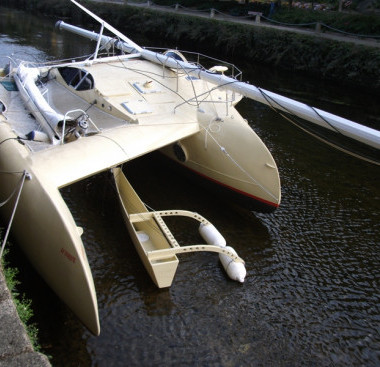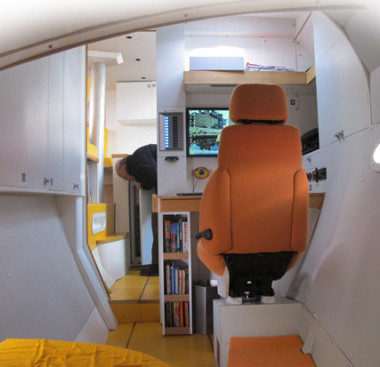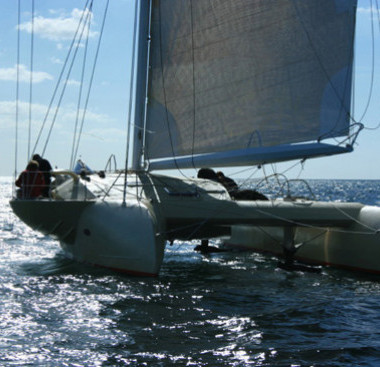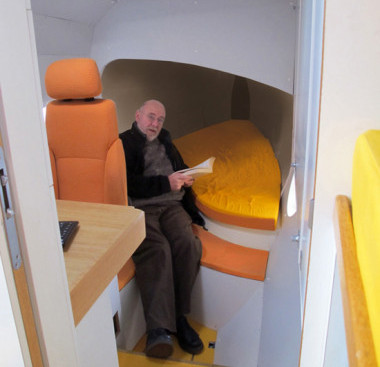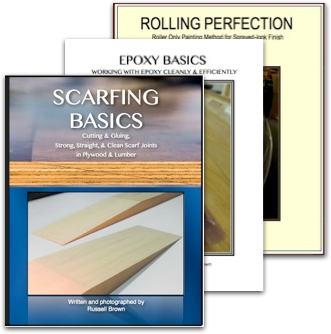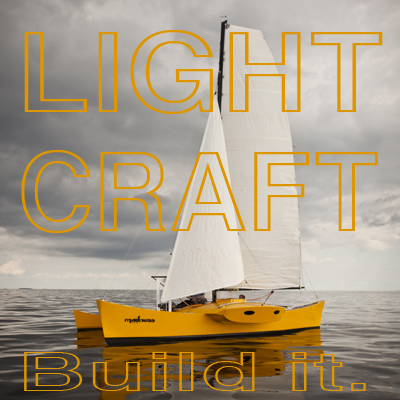Exclusive: Epicure, 47’ Cruising Proa
I am pleased to present the proa Epicure. Epicure is one of the most interesting modern proas ever built, and certainly one of the best looking and most original. Belgian-French yacht designer Daniel Charles tells us more about his incredible yacht, which is now being seriously offered for sale. IMHO, this opportunity is like finding a Bugatti in the barn. In other words, a golden one.—Editor
Epicure is a cruising proa which started building in 2003 and was launched in 2010. At 47’ long, she is an attempt at having a live-aboard cruising boat with all the modern comforts (heating, fridge, deep-freezer, oven & microwave, dishwasher, washing-drying machine…) and the modern helps (with electric winch and windlass). She took me eight years to design and build, but in truth I’d been thinking of her for thirty years.
I’ve previously designed two large proas: the 54’ ‘Tahiti Douche’ in 1980 and the 56’10” ‘Eka Grata’ in 1982. Tahiti (who still exists) was a racing boat designed in 11 days; she was an Atlantic proa, although with very different hull shapes than ‘Cheers’; ‘Eka Grata’ (destroyed following grounding) was a cruising boat, I believe the first modern multihull with divergent beams and, with the lee hull longer than the windward hull, the first approach of what I call the Indian proa (more on this anon). The experience on these two craft, plus sailing on most of the (then) contemporary proas of different types (Cheers, Eterna, Jzero…), convinced me of the superiority of the proa formula in two rarely mentioned domains. First, the very low centre of gravity gives a softness of motion unequalled by any multihull. Second, Atlantic or Indian proas have large water-plane area for their weight and as a result suffer less than any other multihull from increased wetted area when one adds weight. This comfort of motion and high payload for weight made a proa ideal as a cruising yacht.
As the start of the 1982 Rum Race, I’d two orders for racing proas; five minutes later, thanks to the antics of the Pacific proa with (very) foldable beam ‘Rosières’, I’d none left and the proas became taboo as allegedly too dangerous. I went off to other things, although I never stopped thinking about proas.
Both proas architectures I found wanting. The Atlantic proa –a trimaran with the windward float missing- was satisfactory from a stability point of view, with the rig and accommodations to windward; however, as soon as the sails pressed upon the boat, the windward hull would raise and the bows up in the air would only increase pitching while the appendages would ventilate. The Pacific proa –a trimaran with the leeward float missing- had one thing right: the main hull, which creates longitudinal stability and whose length has to be maximized for speed, is the leeward hull; however, the stability here is function of the weight one could move to windward (perfect if crew weight is a large percentage of the displacement, but on a large boat impractical), and there were few safe ways to stay the rig to leeward (and an unstayed rig carries its penalties in expense of the mast and torsion stiffness of the hull). I wanted a proa which would combine the advantage of the two formulas: of the Pacific, it would have the longer, most powerful hull to leeward; of the Atlantic, it would have the rig and accommodations and weight to windward. Since between the Pacific and the Atlantic there is the Indian Ocean, I called this architecture the Indian proa.
The theoretical concept was defined as early as ‘Eka Grata’ in 1982 –but the boat’s 5000-mile long trek in Atlantic and the Med was unpublicized. At the beginning of this century an unexpected influx of money allowed me to consider what boat I’d design for myself. I needed payload. Being well past my prime, I needed help (indeed the first thing I bought was a large electric winch) and real comfort. Actually, I wanted to prove that one didn’t need a large heavy yacht to have all the equipment needed: Epicure would be a technology demonstrator of onboard comforts. I had the luck of being accompanied there by Victron, who designed the energy system. With a Sterling generator, electricity comes with nearly no noise and an extremely low environmental imprint. I also wanted Epicure to be a normal yacht –with EU certification, the first proa to be so. And since Nature had given me two left hands with all thumbs, the boat would have to be built professionally.
Particulars
Epicure is an Indian proa built by Alu Yachting of Quimperlé (South Britanny) in welded alloy, chosen for its cost and strength. Lee hull is 47’ long (14.5m), windward hull 35’ long (10.75m), beam 23’7” (7.19m) with 15’ between axis (4.6m). Cockpit to windward is the driest place on board. Weight complete without crew, food or diesel, in 11900 lb. (5400kg). The rig is a cat boat (una rig-Editor), to avoid the jib problems when shunting: there is a single mainsail (North 3DL) of 1050 sq.ft (96m²) –the electric winch does make it easier! A flying jib can be rigged in light air. This made for a Bruce Number of 1.46 with the main alone; with the flying jib it’ll jumps to 1.99, quite unusual for a cruising boat with a washing machine! Motorization is a 15hp diesel outboard prototype (with Hatz engine), raised with an electric winch. There are two bow thrusters, to help with docking and when taken aback.
The appendages were of the trailing sort commanded by flettners, the fore one acting as a canard rudder, the aft one acting as centerboard. Despite all the great minds that helped design this system, it proved unsatisfactory and is currently being replaced by one close to the well-tried Eka Grata’s one.
Accommodations have been built by Yachting Amenagements of Vannes (South Britanny) in balsa core plywood. There are two cabins (one in each windward bow), one with a navigation area (and a 24” computer screen), each with a separate settee and vast amounts of storage and hanging spaces. The lounge with panoramic view can be transformed into a king size bed. The galley is made of three connected areas: working, cooking, hardware (oven, microwave and dishwasher); floor space there is 22 sq. ft. (2m²). There is an electric toilet, with hot shower and a home sized washing drying machine. From experience, the accommodations are extremely pleasant: it’s a real home. Those who criticize the washer-dryer don’t know the pleasure, after working under the rain all day, of getting cloths dry and warm; and the dishwasher critics won’t know the joy of having crystal clear glasses while using less water than it would take to wash them badly by hand. Of course, to enjoy all that one needs the Victron electric system which is a wonder (albeit a complex one).
The experience has not come easily. For eight years my all life turned around Epicure, and she swallowed all the money I earned and then all I could borrow. Eventually the costs went way, way past the half million euros mark: the problem with a radical boat professionally built is that the professionals don’t know how much work there is going to be…
During the fitting out, I’d the unpleasant surprise to measure how much I’d aged in eight years. The boat is up to the task, but I’m not up to the boat anymore, and my physical health is worsening while my financial one is beyond description. It’s time somebody fresh takes over the project and makes the boat alive. Therefore I’ve decided to put her on sale for a fraction of her cost. It’s the opportunity to have an exciting, spectacular, splendidly comfortable seagoing proa cheaper than a used cat. Of course it breaks my heart (not to speak of my wallet) but it’s much better than if Epicure were not used as she deserves.
Daniel Charles
daniel.charles2 (at) wanadoo.fr
